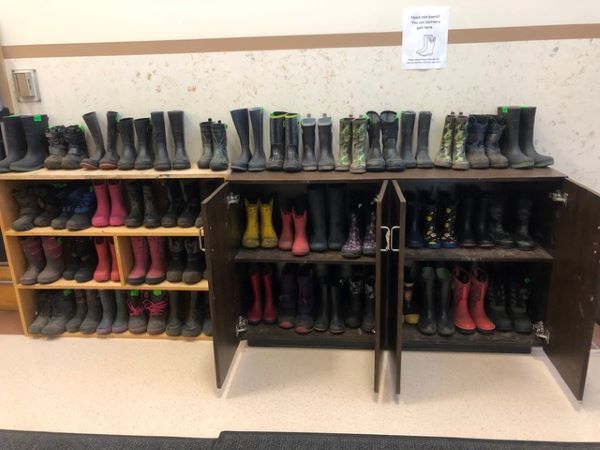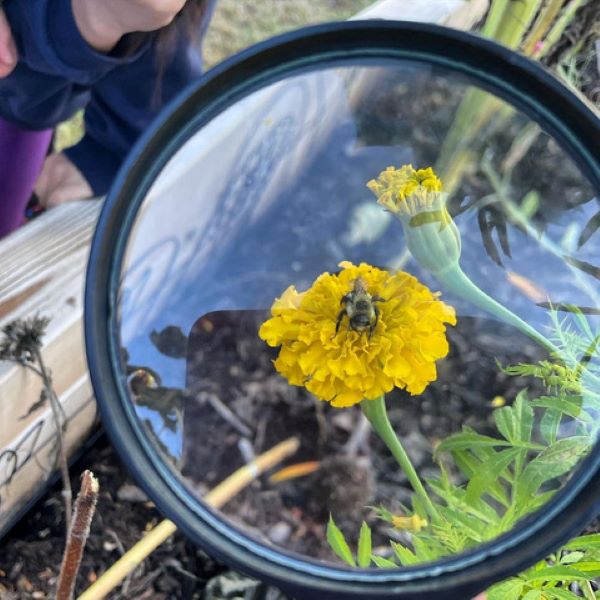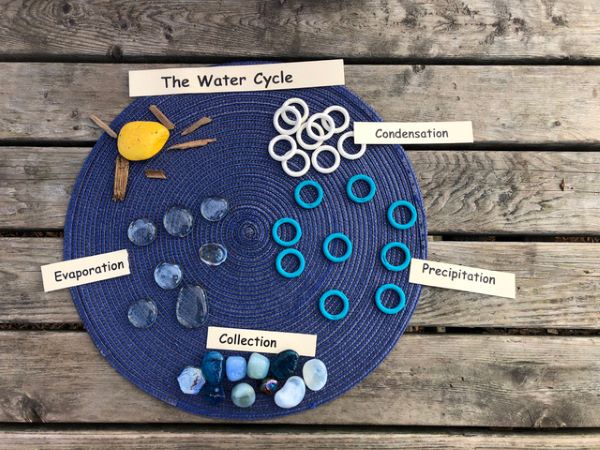I’m a public elementary school teacher and I teach entirely outdoors in an outdoor classroom and garden. The number one question I get is, “what do you do when it is raining?” Living on the Westcoast of Canada means it rains all the time, and if we waited for good weather, we would miss the abundance of rich learning that emerges when we take our learning outside in all weather and across all seasons!
Prepare for the weather
Our Westcoast winters are very wet, which means we prepare an extensive gear lending library so everyone can be dry and warm. Our stash of waterproofs was built up over the years with strategic harvesting from the lost and found, donations from families whose children had outgrown their gear, and targeted purchases to round out our collection of boots, rain pants and jackets.
Children borrow for the hour, the day, the week, or sometimes for the entire year! Take what you need and donate what you can has been our only rule.

Embrace an emergent curriculum
Teachers who embrace an emergent curriculum hold space for children to explore and play outdoors during instructional time. The role of the teacher in an emergent curriculum is to watch closely for the wonders and questions that emerge as children begin to make sense of the world around them. Teachers can offer invitations for deepening learning, and scaffold new learning by curating books and resources (like magnifying lenses) that further engage children in their inquiry.
By strategically noticing and naming the phenomenon that children encounter, teachers can build scientific literacy while laying a foundational love of lifelong learning.

Re-imagine where learning can happen
An easy entry point for teachers who have never tried teaching outdoors is to simply re-imagine where classroom learning might happen.
If you usually read aloud at the carpet, try reading under a tree gathered on a tarp. If you have a lesson in math, literacy, or science in your day plan, look at your plans and ask yourself, “what about this lesson needs to be taught indoors?” and then try teaching it outside.
Begin to plan your day through the lens of simply locating your learning outdoors, and you will naturally begin to replace worksheets and textbooks with meaningful experiences that connect your learners to the seasonality of place. Your students might never remember the best worksheet you made for them on water cycles, but they will absolutely remember the time you took them all outside to experience the water cycle by jumping and splashing in puddles.
Assessment of emergent learning can be equitably conducted when invitations to ‘show what you know’ (about the water cycle, for example) allows students to make their learning visible in a personalized way.

There’s a book for that
You don’t need to be an outdoor enthusiast, or have a degree in botany, to feel competent and capable taking your learners outdoors.
Besides the abundance of resource texts for teachers that exist to support you as you reimagine where learning happens in your school, there is an anchor text that can support just about any concept, or lesson you’d like to teach outdoors.
Ask your school librarian for texts about soil, weeds, bees, slugs and just about anything else you encounter outdoors! By positioning yourself as a co-learner with your students, you powerfully model the inquiry process.
It’s important for children to understand that learning is a life-long process, and teachers who help children harness their curiosity with reliable and accurate sources of information, to name insects or identify tracks in the snow, for example, help children become competent readers for information.
Start small and have fun!
Just about every curricular concept can be taught outdoors. Start with a content area you enjoy and develop routines to support teaching that singular concept outside. Build on your success by regularly scheduling learning outdoors and start curating teaching resources that have some all-weather durability. If you want to know more about transitioning to teaching outdoors, you can read more in this blog post!
References
Louv, Richard (2008). Last Child In The Woods: Saving Our Children From Nature-Deficit Disorder. Algonquin Books.
Robertson, Juliet (2014 ). Dirty Teaching: A Beginner’s Guide to Learning Outdoors. Independent Thinking Press.
Sobel, David (2008). Childhood And Nature: Design Principles For Educators. Stenhouse Publishers.
Young, John; Haas, Ellen; McGowan, Evan (2010). Coyote’s Guide To Connecting With Nature. Owlink Media.


